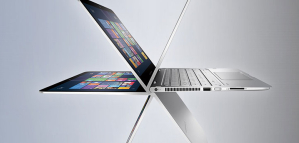
Hewlett-Packard Co. has released the Spectre x360 for public sale on Monday, which was designed with the help of Microsoft and will attempt to compete with Apple MacBook Air and Lenovo Yoga models.
According to HP.com, which also has the Spectre x360 on sale now, the prices start between $899.99 (for a basic model) and $1149.99. The company's marketing tactics touted a newly designed hinge as one of its main features.
"With the newly designed hinge, transitions are synchronized with precise movement and are smoother than ever before," HP wrote in promoting the product. "Open the Spectre x360 with a touch of a finger and angle it to any position with ease. Simple and elegant, the hinge blends seamlessly into the spine of the notebook and even allows it to lay flat in tablet mode."
HP's website also emphasized the battery life of the Spectre x360.
"Thanks to thoughtful engineering, we built the Spectre x360 using fewer parts, which allowed us to create a strong and light convertible PC with a thin and powerful polymer battery," HP wrote. "Up to 12.5 hours of battery life lets you get back to doing the things you love without being chained to an outlet."
Brian Westover of PC Magazine managed to secure a Spectre x360 and ran it through various tests. He noted that it had "the look and feel of a premium ultraportable laptop" and described its unique design elements.
"The minimalist, bare-metal construction is machined out of a single piece of aluminum, offering strength and rigidity in the chassis while keeping everything lightweight," Westover wrote in describing the aluminum unibody design. "A few millimeters of space mean more room for the battery, and HP crams in a 56Wh battery that should provide up to 10 hours of battery life with continuous use."
Westover also loved the way the laptop was held together by the hinge, adding that it was "extremely well thought out."
"While most other 360-degree hinges simply use a dual-axle design with friction hinges, HP has built a geared cam linkage into each hinge," Westover wrote. "Each hinge axle is actually a spiral gear, with the two linked by another spiral gear, causing both to rotate in perfect synchronization."
Westover elaborated on the hinge, which is aimed to draw attention from anyone familiar with Lenovo Yoga desktops.
"Notebook mode is fairly basic, but the hinges allow the lid and display to be opened further, to lay flat, fold around into Display or Tent mode, and finally fold back flat into tablet mode," Westover wrote. "Between the hinge mechanism and the chassis design, there's no change in thickness between the closed laptop and the tablet-both measure a svelte 0.62 inches thick."
However, Dana Wollman of Engadget reported that HP collaborated with Microsoft in developing the Spectre x360. He described how the production process hashed out between both iconic computer technology companies.
"Over the course of a year and a half, the two companies met regularly to hash out everything from the BIOS, fan noise and wireless range, even obsessing over details like the screen's color gamut," Wollman wrote. "The result is a well-built laptop that promises long battery life, fast performance and one clean OS install. If you've ever speculated about whether Microsoft might make its own clamshell notebook, this is probably the closest you're going to get."
Wollman reported that unlike Lenovo, HP was able to achieve a technological breakthrough in developing its latest laptop.
"Unlike Lenovo, HP figured out how to design a 360-degree hinge that somehow folds into itself -- meaning the laptop is equally thick whether it's in tablet or regular notebook mode," Wollman wrote.
Wollman noticed that the Spectre x360 had a lot of ports, which included "HDMI, a Mini DisplayPort and three USB 3.0 sockets." HP also included an adapted for those who used Ethernet jack, VGA dongle, or both.
In terms of Wi-Fi performance, Westover described how the HP laptop's dual-band 802.11ac Wi-Fi worked.
"It uses a 2x2 MIMO setup to increase throughput, and instead of situating the Wi-Fi antennas behind a stripe of radio-transparent plastic, the Spectre x360 has specially designed antennas fitted into open slots in the laptop's lid," Westover wrote. "The end result should be better Wi-Fi performance without disrupting the clean minimalist design."
According to Wollman, one advantage to getting this HP laptop is that Microsoft didn't let the computer maker load it up with too much unnecessary software known as "crapware." HP Technical Marketing Manager Kevin Wentzel told Wollman that it was "one of the cleanest images HP ever produced."
"To be clear, it's not entirely free of bloatware, but it's close," Wollman wrote. "My test machine came with Netflix and The Weather Channel, as well as Hearts Deluxe and a few of HP's own apps, like Connected Photo. So, not a Microsoft Signature Series machine, exactly, but it's a step in the right direction."
For those interested in buying the Spectre x360, Westover reported that it is already available on HP.com and will hit Best Buy shops starting on March 15. However, a high-end model of the laptop, which has "a Quad HD display, Core i7 processor, 8 GB of RAM, and 512GB SSD," will hit the U.S. market sometime in early April and will retail for $1,399.99.







